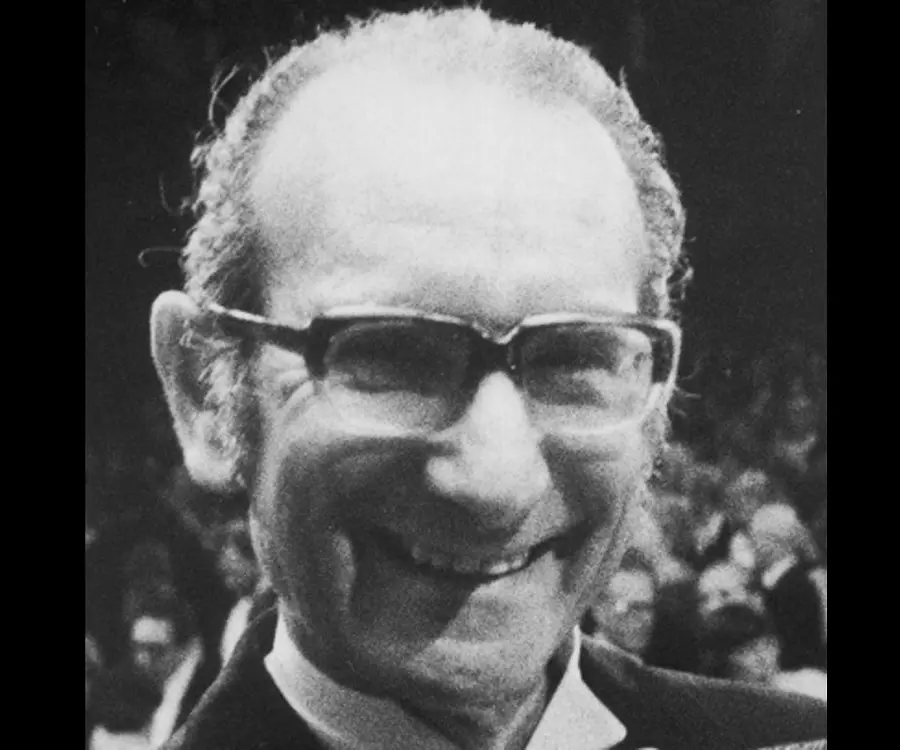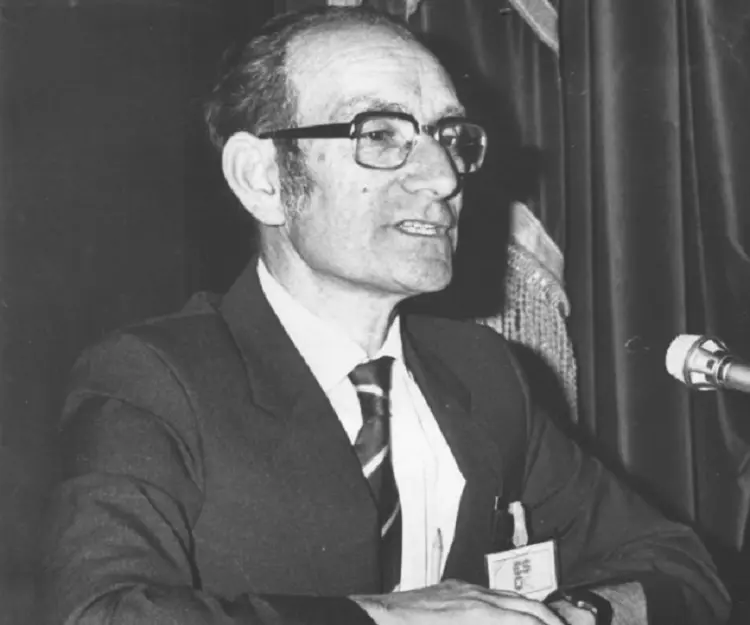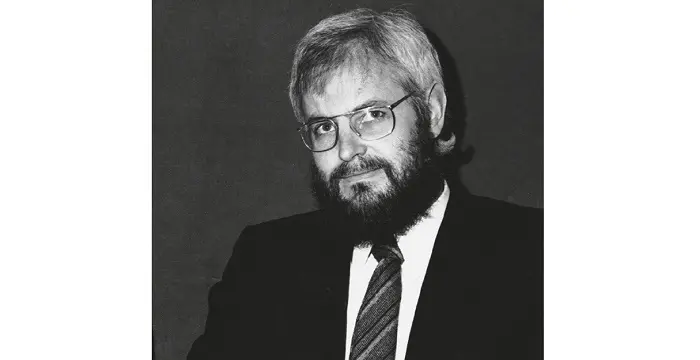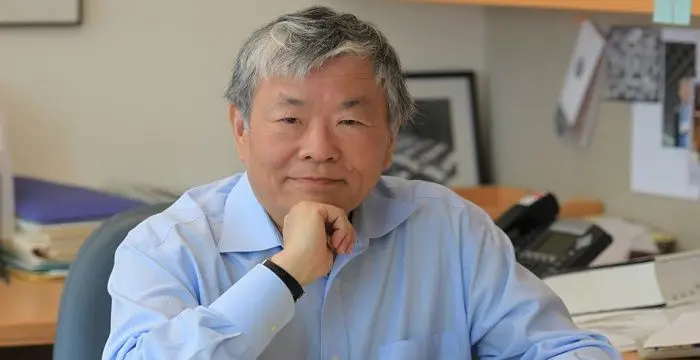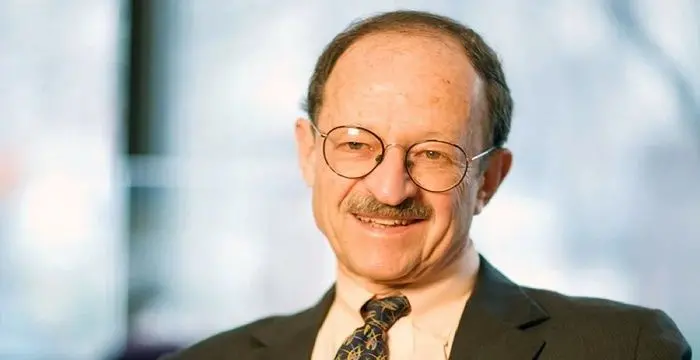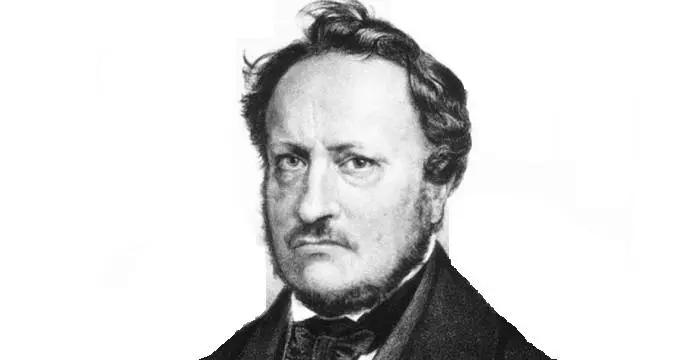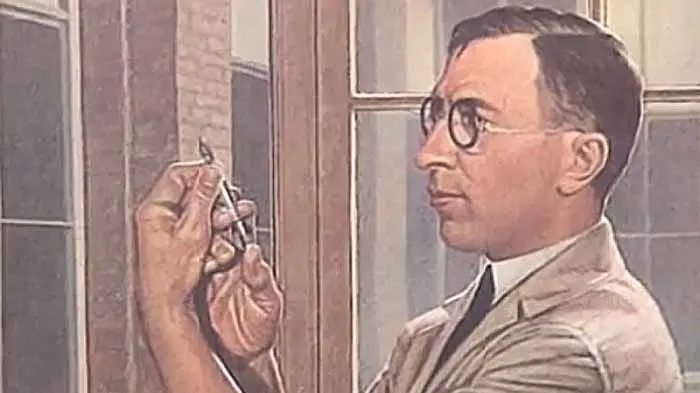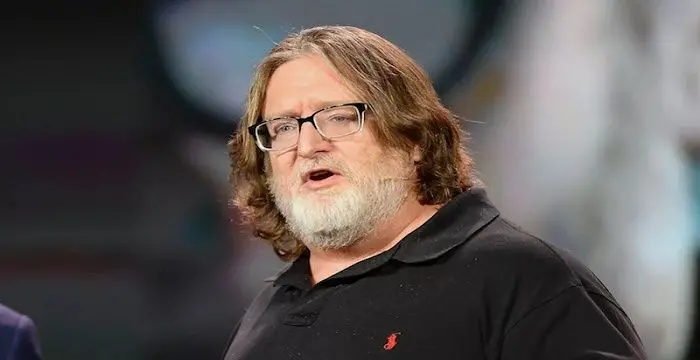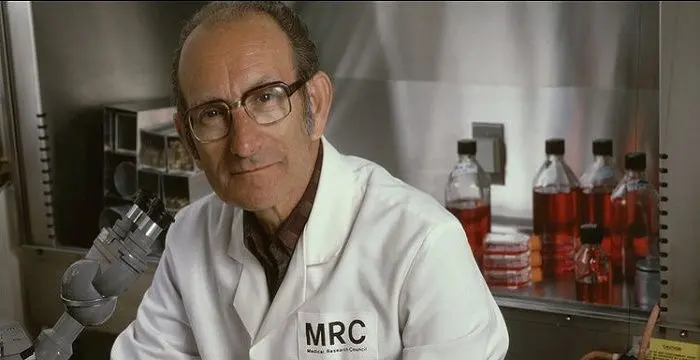
Cesar Milstein - Medical Scientists, Facts and Facts
Cesar Milstein's Personal Details
Cesar Milstein was an Argentinian biochemist who received the Nobel Prize for his discovery of monoclonal antibody
| Information | Detail |
|---|---|
| Birthday | October 8, 1927 |
| Died on | March 24, 2002 |
| Nationality | Argentinian |
| Famous | Scientists, Immunologists, Medical Scientists, Biochemists |
| Birth Place | Bahía Blanca, Argentina |
| Gender | Male |
| Sun Sign | Libra |
| Born in | Bahía Blanca, Argentina |
| Famous as | Biochemist, Immunologist |
| Died at Age | 74 |
// Famous Biochemists
Robert Huber
Robert Huber is a German biochemist and Nobel Laureate. Check out this biography to know about his childhood, life, achievements, works & timeline.
Charles Best
Charles Best was a great scientist and a renowned physiologist who is remembered for being the co-discoverer of insulin. Read this biography to learn about his profile, childhood, life and timeline.
Isaac Asimov
Isaac Asimov was an American professor of biochemistry and a renowned author of science fiction and popular science books. Read this biography to know more about his life.
Cesar Milstein's photo
Who is Cesar Milstein?
Cesar Milstein was an Argentinian biochemist and immunologist who was bestowed with Nobel Prize in Physiology or Medicine in 1984 for his path-breaking work in the development of monoclonal antibodies. The work made him one of the most important scientists of the 20th century and his discovery one of the most important discoveries of the 20th century. A University of Buenos Aires alumnus, Milstein’s research in the field of immunology and immunogenetics began when he acted upon Frederick Sanger’s suggestion. Previously working on enzymology, Milstein shifted his focus to immunology. He collaborated with Georges Kohler to develop the hybridoma technique for the production of monoclonal antibodies. The duo pioneered the seminal technique for the production of monoclonal antibodies which created a rage in the scientific society. In 1975, they came up with a paper that published their discovery and later also displayed the clinical application. Apart from the discovery of monoclonal antibody, Milstein researched on the structure of antibodies and their genes, through the investigation of DNA and RNA. This research became fundamental for a better understanding of the functioning of the human immune system. In his lifetime, Milstein was showered with prestigious scientific awards and became a member of numerous scientific societies and institutions.
// Famous Immunologists
Georges J. F. Kohler
Georges J. F. Kohler was a German immunologist who received the Nobel Prize in Physiology or Medicine in 1984. Check this biography to get details about his life, profile and timeline.
Susumu Tonegawa
Susumu Tonegawa is a Japanese molecular biologist who was awarded the Nobel Prize for Physiology or Medicine in 1987. This biography of Susumu Tonegawa provides detailed information about his childhood, life, achievements, works & timeline.
Harold E. Varmus
Harold E. Varmus is an American scientist who won a share of the 1989 Nobel Prize in Physiology or Medicine. This biography of Harold E. Varmus provides detailed information about his childhood, life, achievements, works & timeline.
Childhood & Early Life
Cesar Milstein was born on October 8, 1927 in Bahia Blanca, Argentina to Maxima and Lazaro Milstein, a Jewish Ukrainian immigrant. His mother belonged to a poor immigrant family and was a teacher by profession. He was the second of the three sons born to the couple.
Milstein’s parents were determined to bring up their children with good education. As such, when young Milstein completed his preliminary studies, he was enrolled at the University of Buenos Aires. Milstein though academically average was active in student union affairs and politics.
Upon completing his graduation from the University, Milstein took a year off, travelling through Europe, before returning to Argentina. He resumed his studies with an aim to get a doctoral degree. Under the guidance of Professor Stoppani, the Professor of Biochemistry at the Medical School, Milstein completed his thesis on kinetics studies with the enzyme aldehyde dehydrogenase.
Career
Immediately following his doctoral degree, Milstein was granted a British Council fellowship which led him to join the biochemistry department at Darwin College, University of Cambridge to work under Malcolm Dixon on the project, mechanism of metal activation of the enzyme phosphoglucomutase. While working with Dixon, he joined Frederick Sanger’s group on a short-term Medical Research Council appointment.
After completing his fellowship and collaboration with Sanger’s group, Milstein returned to Argentina in 1961 for a period of two years. Therein, he served as the head of the then newly created Department of Molecular Biology at the National Institute of Microbiology in Buenos Aires. During this time, he extended his study of mechanisms of enzyme action to the enzymes phosphoglyceromutase and alkaline phosphatase.
The 1962 military coup which resulted in the dismissal of Institute’s director Ignacio Pirosky forced Milstein to resign and return to Cambridge.
At Cambridge, Milstein re-joined work with Sanger, who meanwhile had been appointed as the Head of the Division of Protein Chemistry in the newly-formed Laboratory of Molecular Biology of the Medical Research Council. On the suggestion of Sanger, Milstein shifted his focus from enzymology to immunology.
For much of the decade of 1960s and 1970s, Milstein concentrated on the study of antibodies, the protein organisms generated by the immune system to combat and deactivate antigens. His efforts were aimed at analysing myeloma proteins (tumors in cells that produce antibodies), and later DNA and RNA.
Milstein’s research on antibodies was crucial in his early career in immunology as it helped him comprehend the fundamentals of antibodies. He searched for mutations in laboratory cells of myeloma, but faced difficulty finding antigens to combine with their antibodies.
For most of his research years, Milstein concentrated on studying the structure of antibodies and the mechanism by which antibody diversity is generated. It was in 1974 that he struck luck along with Georges Kohler, a postdoctoral fellow at his laboratory, when they produced a hybrid myeloma called hybridoma.
Hybridoma had the capacity to produce antibodies but kept growing like the cancerous cell from which it had originated. The production of monoclonal antibodies from these cells became one of the most important discoveries of decade.
Milstein came up with the Milstein-Kohler paper in 1975 wherein the duo first brought to light the possibility of using monoclonal antibodies for testing antigens. They also predicted the possibility to hybridize antibody-producing cells from different origins, stating that the cells could be produced in massive cultures. The discovery was crucial and led to an enormous expansion in the exploitation of antibodies in science and medicine.
By 1977, Milstein was flooded with requests for samples of monoclonal antibodies, so much so, that he had to search for outside support in the distribution process. This paved way for the earliest wide-scale commercialisation of monoclonal antibodies.
His research work did not end with the discovery of monoclonal antibodies. He furthered his research by making major contributions in the improvement and development of monoclonal antibody technology by focusing on the use of monoclonal antibodies.
Together with Claudio Cuello, Milstein laid the foundation for the use of monoclonal antibodies for the investigation of the pathological pathways in neurological disorders as well as many other diseases. Their work assisted in the use of monoclonal antibodies to enhance the power of immuno-based diagnostic tests.
Milstein predicted the potential of applying recombinant DNA technology to monoclonal antibodies that could result in ligand-binding reagents. He also inspired the development of the field of antibody engineering which lead to safer and more powerful monoclonal antibodies for use as therapeutics.
In 1983, Milstein took up leadership role in the Protein and Nucleic Acid Chemistry Division at the Medical Research Council's laboratory.
Later in his career, Milstein guided and inspired many in the field of antibody. He devoted himself to assist scientists in less developed countries.
Major Works
Milstein’s most important contribution came in the decade of 1970 when, he, together with Georges Kohler, made revolutionary discovery in the field of immunology and immunogenetics. He came up with theories concerning the specificity in development and control of the immune system and the discovery of the principle for production of monoclonal antibodies. Interestingly, Milstein’s research did not end with the discovery of monoclonal antibody alone. He furthered his research by making major contributions in the improvement and development of monoclonal antibody technology by focusing on the use of monoclonal antibodies.
Awards & Achievements
In 1984, Milstein was conferred with the prestigious Nobel Prize which he shared with Köhler for developing the technique that had revolutionized many diagnostic procedures by producing exceptionally pure antibodies. The duo had discovered monoclonal antibodies.
He was a member of numerous international scientific organizations, including the U.S. National Academy of Sciences and the Royal College of Physicians in London.
Personal Life & Legacy
Cesar Milstein met Celia Prilleltensky, his future wife, while he was studying in the University of Buenos Aires. The two hit it off instantly and married immediately following their graduation in 1953. They spent a year honeymooning, hitch-hicking across Europe before returning to Argentina to resume studies.
Milstein died of a heart condition on March 24, 2002 in Cambridge, England, at the age of 74.
Trivia
Interestingly, Milstein did not patent his enormous discovery since he believed that it was mankind's intellectual property.
// Famous Medical Scientists
Johannes Peter Müller
Johannes Peter Müller was a German physiologist and comparative anatomist. Check out this biography to know about his childhood, life, achievements, works & timeline.
Frederick Banting
Frederick Banting was a Canadian medical scientist and physician who won the Nobel Prize for discovering insulin. Check out this biography to know about his childhood, family life, achievements and other facts related to his life.
Harold E. Varmus
Harold E. Varmus is an American scientist who won a share of the 1989 Nobel Prize in Physiology or Medicine. This biography of Harold E. Varmus provides detailed information about his childhood, life, achievements, works & timeline.
Cesar Milstein's awards
| Year | Name | Award |
|---|---|---|
Other | ||
| 1980 | Wolf Prize in Medicine | |
| 1982 | Royal Medal | |
| 0 | Franklin Medal | |
| 1984 | John Scott Legacy Medal and Premium | |
| 1981 | Gairdner Foundation International Award | |
| 1980 | Louisa Gross Horwitz Prize | |
| 1980 | Robert Koch Prize | |
| 1981 | William Bate Hardy Prize | |
| 0 | 1984 - Nobel Prize in Physiology or Medicine | |
| 0 | 1984 - Albert Lasker Award for Basic Medical Research | |
| 0 | 1989 - Copley Medal | |
Cesar Milstein biography timelines
- // 8th Oct 1927Cesar Milstein was born on October 8, 1927 in Bahia Blanca, Argentina to Maxima and Lazaro Milstein, a Jewish Ukrainian immigrant. His mother belonged to a poor immigrant family and was a teacher by profession. He was the second of the three sons born to the couple.
- // 1953Cesar Milstein met Celia Prilleltensky, his future wife, while he was studying in the University of Buenos Aires. The two hit it off instantly and married immediately following their graduation in 1953. They spent a year honeymooning, hitch-hicking across Europe before returning to Argentina to resume studies.
- // 1961After completing his fellowship and collaboration with Sanger’s group, Milstein returned to Argentina in 1961 for a period of two years. Therein, he served as the head of the then newly created Department of Molecular Biology at the National Institute of Microbiology in Buenos Aires. During this time, he extended his study of mechanisms of enzyme action to the enzymes phosphoglyceromutase and alkaline phosphatase.
- // 1962The 1962 military coup which resulted in the dismissal of Institute’s director Ignacio Pirosky forced Milstein to resign and return to Cambridge.
- // 1970Milstein’s most important contribution came in the decade of 1970 when, he, together with Georges Kohler, made revolutionary discovery in the field of immunology and immunogenetics. He came up with theories concerning the specificity in development and control of the immune system and the discovery of the principle for production of monoclonal antibodies. Interestingly, Milstein’s research did not end with the discovery of monoclonal antibody alone. He furthered his research by making major contributions in the improvement and development of monoclonal antibody technology by focusing on the use of monoclonal antibodies.
- // 1974For most of his research years, Milstein concentrated on studying the structure of antibodies and the mechanism by which antibody diversity is generated. It was in 1974 that he struck luck along with Georges Kohler, a postdoctoral fellow at his laboratory, when they produced a hybrid myeloma called hybridoma.
- // 1975Milstein came up with the Milstein-Kohler paper in 1975 wherein the duo first brought to light the possibility of using monoclonal antibodies for testing antigens. They also predicted the possibility to hybridize antibody-producing cells from different origins, stating that the cells could be produced in massive cultures. The discovery was crucial and led to an enormous expansion in the exploitation of antibodies in science and medicine.
- // 1977By 1977, Milstein was flooded with requests for samples of monoclonal antibodies, so much so, that he had to search for outside support in the distribution process. This paved way for the earliest wide-scale commercialisation of monoclonal antibodies.
- // 1983In 1983, Milstein took up leadership role in the Protein and Nucleic Acid Chemistry Division at the Medical Research Council's laboratory.
- // 1984In 1984, Milstein was conferred with the prestigious Nobel Prize which he shared with Köhler for developing the technique that had revolutionized many diagnostic procedures by producing exceptionally pure antibodies. The duo had discovered monoclonal antibodies.
- // 24th Mar 2002Milstein died of a heart condition on March 24, 2002 in Cambridge, England, at the age of 74.
// Famous Scientists
Juliane Koepcke
Juliane Koepcke is a German-Peruvian biologist, who was the lone survivor among the 92 passengers and crew of the ill-fated LANSA Flight 508 that crashed in the Peruvian rainforest on 24 December 1971. Know more about her life in this biography.
Henry Cavendish
Henry Cavendish was a theoretical chemist and physicist, renowned for discovery of hydrogen and calculation of the mass of earth. To know more about his childhood, profile, timeline and career read on
Konstantin Tsiolkovsky
Konstantin Tsiolkovsky was a Russian rocket scientist and a pioneer of astronautics. This biography provides detailed information about his childhood, family, personal life, career, achievements, etc.
Gabe Newell
Gabe Newell is an American computer programmer and businessman, best known as the co-founder of ‘Valve Corporation.’ This biography provides detailed information about his childhood, family, personal life, career, etc.
Grigori Perelman
Grigori Perelman is a Russian mathematician who is best known for his contributions to Riemannian geometry and geometric topology. Check out this biography to know about his childhood, family life, achievements and fun facts about him.
Eduardo Saverin
Eduardo Luiz Saverin is a Brazilian internet entrepreneur and investor. This biography profiles his childhood, life, career, achievements, and timeline
Cesar Milstein's FAQ
What is Cesar Milstein birthday?
Cesar Milstein was born at 1927-10-08
When was Cesar Milstein died?
Cesar Milstein was died at 2002-03-24
Which age was Cesar Milstein died?
Cesar Milstein was died at age 74
Where is Cesar Milstein's birth place?
Cesar Milstein was born in Bahía Blanca, Argentina
What is Cesar Milstein nationalities?
Cesar Milstein's nationalities is Argentinian
What is Cesar Milstein's sun sign?
Cesar Milstein is Libra
How famous is Cesar Milstein?
Cesar Milstein is famouse as Biochemist, Immunologist




